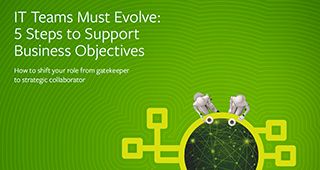Before we can start talking about roadmaps, we need to understand what one is. An IT roadmap is a strategic tool that can help graphically illustrate both long-term and short-term plans. In short, it says where you are and where you plan on going within the next few years. There are several different types of roadmaps depending on what area you want to chart a course for. This article takes a look at a few of the different types of roadmaps and provides some samples that you can leverage in your own strategic planning initiatives.
Service Roadmap
The service roadmap is focused on the IT Services that you provide the organization. These can be especially useful when explaining what services you plan on retiring or spinning up over the next few years. The service roadmap contains a list of all your services. It allows you show at a glance what services you are spinning up, which ones you are maintaining, and which services are in preparation for retirement. You can also show what services will replace any services that may be scheduled for retirement.
Great Examples:
University of Michigan
One excellent example is from University of Michigan. They have developed a concept called a Michigan Enterprise Strategic Assessment (MESA). This is one of the few examples I have seen that breaks the traditional graphical “Gantt style” representation of a roadmap. They instead plot services on a curve that provides a lot of information at a quick glance. Take a look at their example at: https://drive.google.com/file/d/0B_rVdFckkPReeDd4cWh1YWRsYjQ/view
Stanford University
Another great example comes from Standford University. In this example, they have developed a service roadmap for their IT Service Management solution. While this example is product specific, the concepts in the roadmap can be translated to just about any software implementation. What makes this roadmap particularly useful is the amount of information that they convey visually at-a-glance. You can see the current service scope as well as when additional features will be implemented on their campus. THey also show what has been funded already and where additional funding is needed. This is a valuable template for any IT leader’s toolkit. https://uit.stanford.edu/service-management/roadmap
University of South Carolina
Another great service roadmap example comes from the University of South Carolina, University Technology Services. They take a different approach in presenting their roadmap. This example shows three main areas of investment as well as what efforts they have deferred. It also provides a great example of what technologies they are retiring, and which ones will be taking their place (if any.) This example is great for CIO’s to get a perspective on all of the systems they are responsible for. https://www.sc.edu/about/offices_and_divisions/university_technology_services/about/it_roadmap.php
Infrastructure Hardware Roadmap
An infrastructure hardware roadmap is focused on the infrastructure equipment in service. This type of roadmap is my favorite way to show senior IT leadership when specific models of gear will be retired. The infrastructure hardware roadmap is best used for areas where you have a large amount of equipment. This one also works great with any spreadsheet application.
One Example
The first column is a list of models of equipment. The second column is the number of that model you have in service. Then, there are additional columns for each fiscal year in which you want to show your intent for that model. Then you color code your intent for each fiscal year. I like using four different colors.

For example:

The technology roadmap lets you see a great deal of information at-a-glance. In our example above you can tell that the Model 5000 switches are being phased out in FY20. However, we are going to keep buying the 7000’s until FY22. For firewalls, we have a contract decision in FY21 and FY22.
In this example I used network switches and firewalls. However, it also works for servers, storage or any component of infrastructure that has a high item count and needs a defined lifecycle.
Strategy Roadmap
A strategy or sometimes called a strategic intent roadmap lays out the work ahead based on the strategic goals of the organization. This type of roadmap provides an excellent way to visualize your strategic plan. In most roadmaps of this style, the organizational goals are on the left side of the roadmap with a Gannt style timeline that describes the implementation timeline. If there are several supporting projects that role up into a larger strategic goal, you can show those individually as well.
Great Example:
Saint Louis University
Saint Louis University has done a very good job with their Strategic Technology Roadmap Summary. This example follows the Gannt style chart. It has a listing of all their IT projects and which goal they align with. They have also added color coding for project status. This is an excellent addition that gives leaders some indication as to which goals are at risk. The only thing missing from this great roadmap is a timeline summary for each goal. Consider using Saint Louis’s roadmap next time you are presenting your strategic plan to an executive committee or board of directors. https://www.slu.edu/Documents/its/ITS%20Strategic%20Technology%20Roadmap%20CY2015-2018.pdf
Technology Roadmap
The technology roadmap typically displays various projects that support technology stacks within your organization. This type of roadmap is typically very high level and is great for demonstrating how your products align with your overall technology portfolio. This is similar to the strategic roadmap. However, rather than being focused on the strategic goals of the organization, it more closely resembles your organizational structure. If you want to see what your network team, Applications, service delivery and other groups have planned at a glance, then the technology roadmap is what you are looking for.
Great Example:
Smartsheet’s Free Roadmap Templates
While Smartsheets offers their own tools for creating roadmaps they have links to several templates that can be used with other products. I especially like their technology roadmap which can be found at the bottom of the page on the link below. It has separate grouping areas for each technology area and also incorporates service quality and trends. It does a great job of combining projects that may not directly align with one it area and projects that do. Best of all, the template is available for download and can be used with your favorite spreadsheet application. https://www.smartsheet.com/free-product-roadmap-templates-smartsheet
Wrap-Up
As you can see, there are several different types of roadmaps that can be used depending on your situation. I have listed just a few examples here, but there are many more to choose from. You may also find roadmaps that are categorized different than what I have presented. Regardless of what type of roadmap you choose, remember that communication is what the listener does. Know who your audience is for your roadmap and make sure you choose a roadmap that aligns with their interests.







